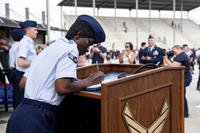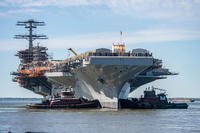After years of combat in the Middle East, the U.S. Army still clings to its desert-colored M1 Abrams tanks and combat vehicles.
This became a challenge for Lt. Gen. Ben Hodges, commander of U.S. Army Europe, when hundreds of M1s began flowing into Europe's woodland landscape to deter Russian aggression.
Hodges recalled watching video with an Air Force friend of tanks arriving in Europe.
"I was like check that out -- U.S. Army, nobody in the world can do that except the U.S. Army," Hodges told an audience at a recent Association of the United States Army breakfast.
"And he goes, 'Why is it tan?'
"I said, 'What do you mean?' And he said, 'Nothing says transient like a tan tank in Europe,' " Hodges recalled, adding that green has become "a strategic communications element for us."
Army M1 tanks and trucks began arriving in Europe in January, marking the beginning of a continuous nine-month rotation of a U.S. armored brigade designed to strengthen deterrence as part of Operation Atlantic Resolve.
It was only three years before that the last American tanks left Europe.
"We thought Russia was going to be our partner," Hodges said. "For the first time since 1944, there were no American tanks in Europe."
He said, 'We have reminded the Army that there are three places that we are probably going to fight with tanks -- two of them are green, and I would rather paint them all green and let somebody come up with a temporary tan job versus doing the other thing."
Since then, some industrious young soldiers discovered how the German Army does winter camouflage, Hodges said.
"They get a big plastic bag full of white chalk, fill it full of water, and it is good for the season. So now that is what we have done," he said.
All joking aside, Russia's ability to use unmanned aerial systems and other assets "to target and destroy everything that is out there has forced us to remember how to camouflage," Hodges said. "That is what everybody is trying to do, is remember these things about force protection and how you survive on the battlefield."
The Army announced increases in end-strength last year that will bring more assets to Europe, he said.
The active Army force increased to 476,000 soldiers; the Army National Guard to 343,000; and the Army Reserve to 199,000.
The service plans to station the following units overseas: a field artillery brigade headquarters with an organic brigade support battalion headquarters, a signal company and a Multiple Launch Rocket System battalion, or MLRS; two MLRS battalions with two forward support companies; a short-range air defense battalion; a theater movement control element; a petroleum support company; and an ammunition platoon.
The Army has also decided to convert an infantry brigade combat team to an armor brigade combat team so it will have a total of 16 ABCTs.
-- Matthew Cox can be reached at matthew.cox@military.com.
Related Video:




























